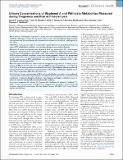| dc.contributor.author | Cantonwine, David E. | en_US |
| dc.contributor.author | Meeker, John D. | en_US |
| dc.contributor.author | Ferguson, Kelly K. | en_US |
| dc.contributor.author | Mukherjee, Bhramar | en_US |
| dc.contributor.author | Hauser, Russ | en_US |
| dc.contributor.author | McElrath, Thomas F. | en_US |
| dc.date.accessioned | 2016-11-18T20:48:33Z | |
| dc.date.issued | 2016 | en_US |
| dc.identifier.citation | Cantonwine, David E., John D. Meeker, Kelly K. Ferguson, Bhramar Mukherjee, Russ Hauser, and Thomas F. McElrath. 2016. “Urinary Concentrations of Bisphenol A and Phthalate Metabolites Measured during Pregnancy and Risk of Preeclampsia.” Environmental Health Perspectives 124 (10): 1651-1655. doi:10.1289/EHP188. http://dx.doi.org/10.1289/EHP188. | en |
| dc.identifier.issn | 0091-6765 | en |
| dc.identifier.uri | http://nrs.harvard.edu/urn-3:HUL.InstRepos:29408408 | |
| dc.description.abstract | Background: Preeclampsia represents a major cause of maternal mortality and morbidity worldwide. Although it is known that the placenta plays a central role in development of preeclampsia, investigation into the contribution of environmental toxicants to the risk of preeclampsia has been sparse. Objectives: In the present study we examined the relationship between longitudinally measured urinary BPA and phthalate metabolite concentrations during gestation and preeclampsia. Methods: A nested case–control study of preterm birth was performed in 2011 from women enrolled in a prospective birth cohort study at Brigham and Women’s Hospital in Boston. There were 50 cases of preeclampsia as part of this study. Urine samples were analyzed for concentrations of BPA and nine phthalate metabolites several times during pregnancy. Adjusted Cox proportional hazard models were used to calculate hazard ratios of preeclampsia in association with an interquartile range increase in BPA and phthalate concentrations and were weighted to reflect results generalizable to the base population. Results: Adjusted hazard ratios indicated that an interquartile range increase of urinary concentrations of BPA (1.53; 95% CI: 1.04, 2.25) and MEP (monoethyl phthalate) (1.72; 95% CI: 1.28, 2.30) at 10 weeks gestation was associated with onset of preeclampsia, whereas significantly elevated hazard ratios were found across gestation for all DEHP [di(2-ethylhexyl) phthalate] metabolites. These relationships differed based on infant sex. Conclusions: Urinary concentrations of BPA and several phthalate metabolites were significantly associated with increased risk of preeclampsia. If validated, these results indicate an environmental contribution of endocrine-disrupting chemicals to preeclampsia and suggest a modifiable means to reduce the mortality and morbidity associated with this condition. Citation: Cantonwine DE, Meeker JD, Ferguson KK, Mukherjee B, Hauser R, McElrath TF. 2016. Urinary concentrations of bisphenol A and phthalate metabolites measured during pregnancy and risk of preeclampsia. Environ Health Perspect 124:1651–1655; http://dx.doi.org/10.1289/EHP188 | en |
| dc.language.iso | en_US | en |
| dc.publisher | National Institute of Environmental Health Sciences | en |
| dc.relation.isversionof | doi:10.1289/EHP188 | en |
| dc.relation.hasversion | http://www.ncbi.nlm.nih.gov/pmc/articles/PMC5047771/pdf/ | en |
| dash.license | LAA | en_US |
| dc.title | Urinary Concentrations of Bisphenol A and Phthalate Metabolites Measured during Pregnancy and Risk of Preeclampsia | en |
| dc.type | Journal Article | en_US |
| dc.description.version | Version of Record | en |
| dc.relation.journal | Environmental Health Perspectives | en |
| dash.depositing.author | Cantonwine, David E. | en_US |
| dc.date.available | 2016-11-18T20:48:33Z | |
| dc.identifier.doi | 10.1289/EHP188 | * |
| dash.contributor.affiliated | Hauser, Russ | |
| dash.contributor.affiliated | McElrath, Thomas | |
| dash.contributor.affiliated | Cantonwine, David | |


